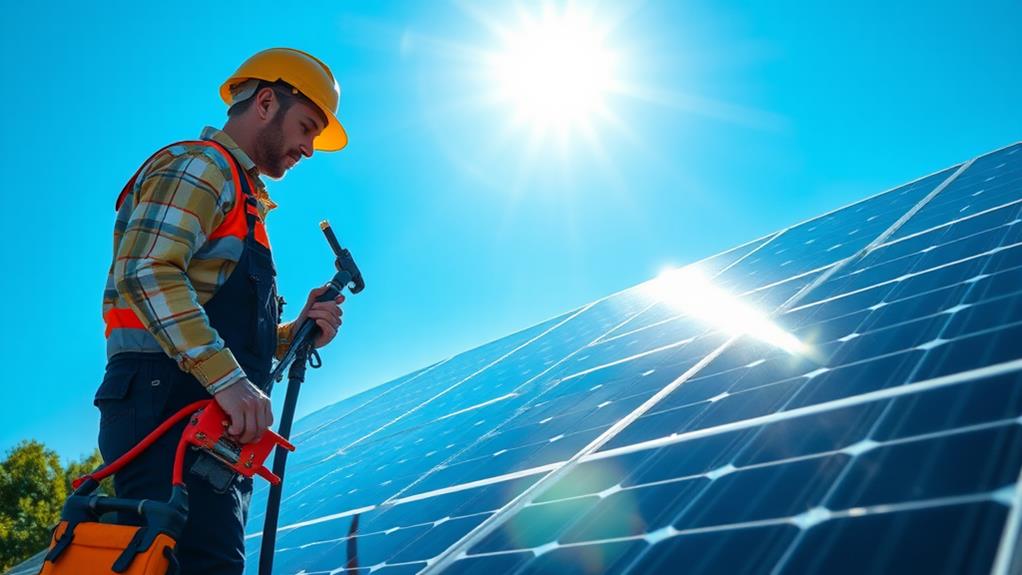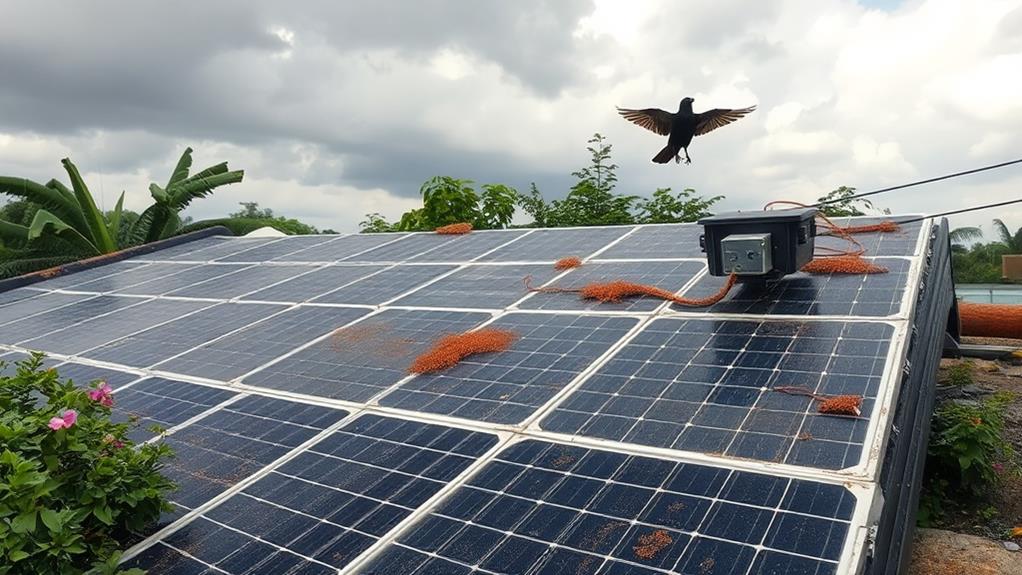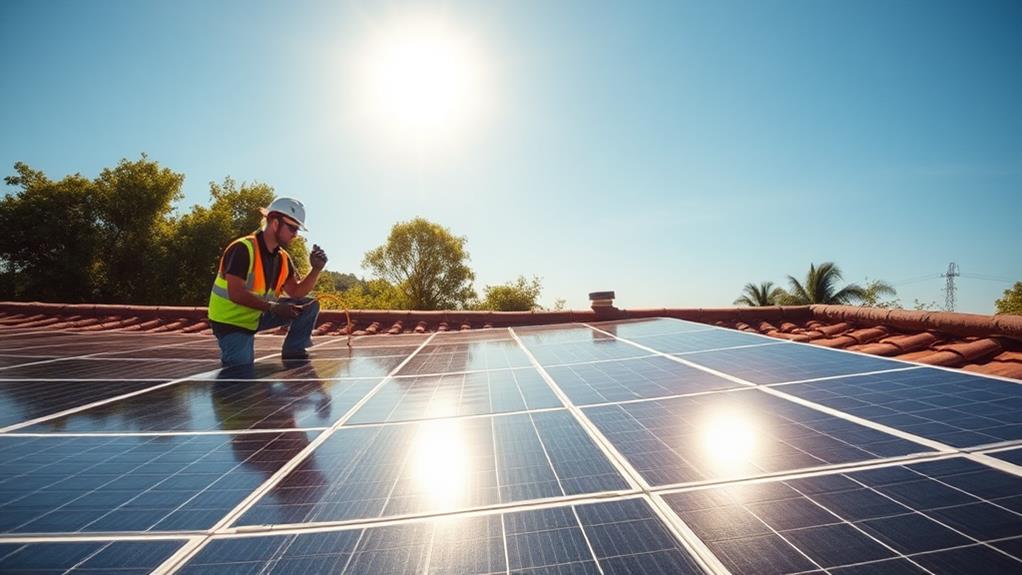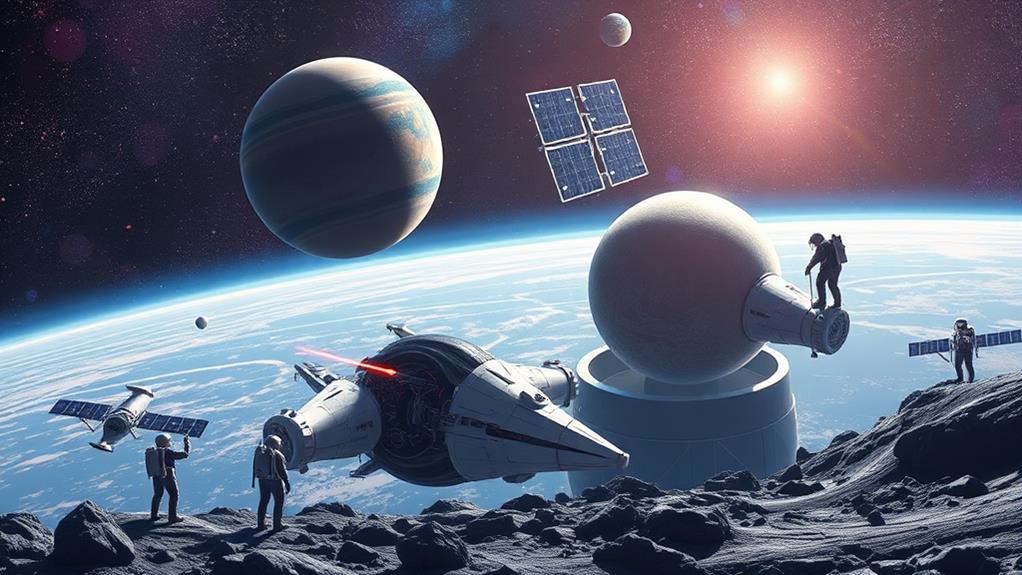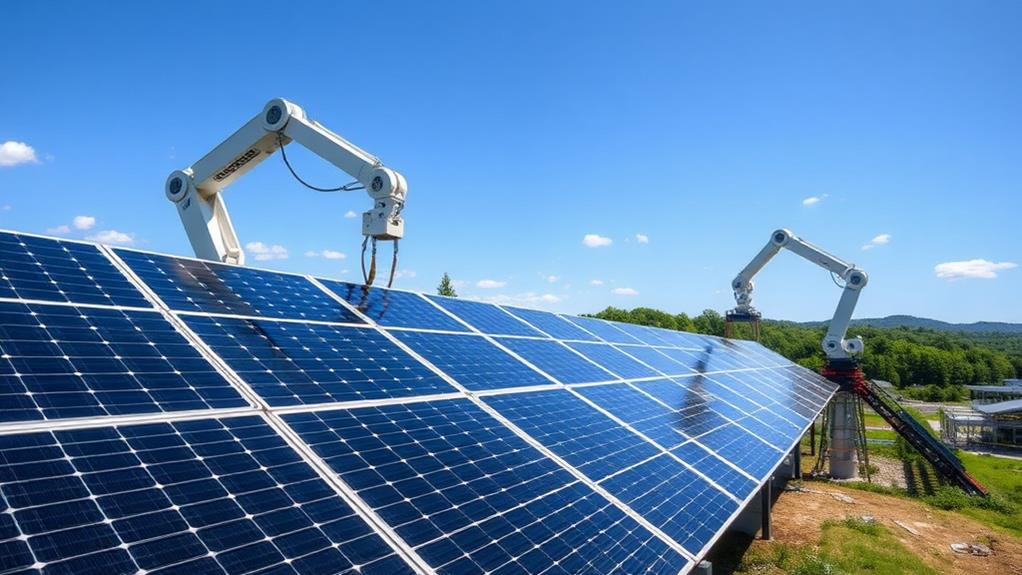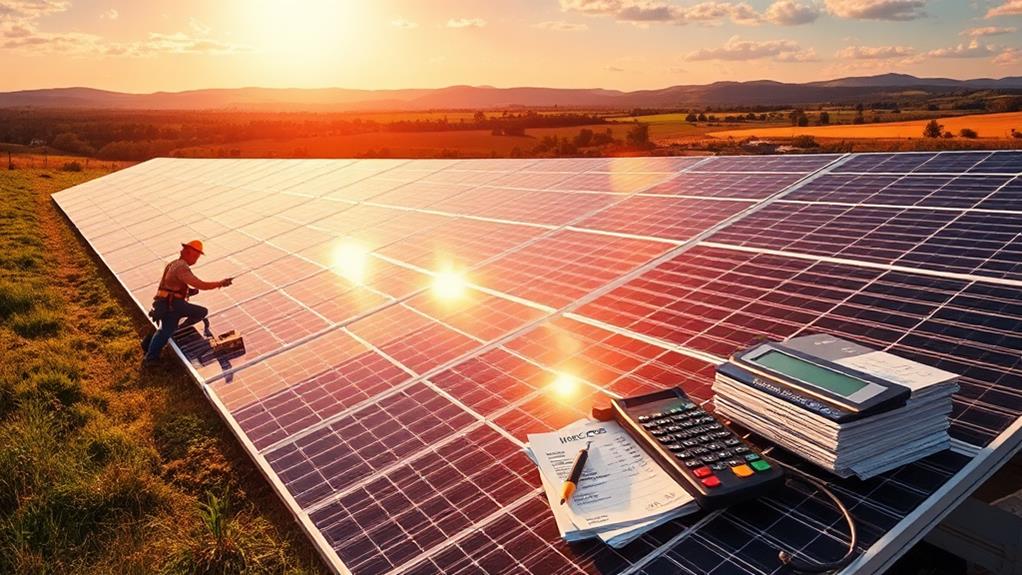Solar mounting systems notably lessen environmental impact by using minimal land and conserving biodiversity. They're made from resilient, reusable materials that support a circular economy, and they necessitate less land modification — making them a sustainable choice. These systems function quietly, reducing noise pollution, and they visually blend into landscapes. Although manufacturing does have emissions, solar solutions still provide a lower lifecycle impact than fossil fuels. Groundbreaking recycling further reduces the ecological footprint, although the management of hazardous materials requires careful handling. Let's delve into the sustainability and potential challenges associated with these systems for a greener future.
Key Takeaways
- Solar mounting systems preserve habitats and biodiversity by requiring minimal land alteration.
- These systems use recyclable, durable materials, promoting a circular economy and sustainability.
- Agrivoltaic solutions and rooftop installations mitigate land use impact and enhance dual land use.
- Nearly silent operation and aesthetic integration minimize noise and visual pollution.
- Sustainable sourcing and material efficiency reduce ecological footprint and support environmental goals.
Benefits of Solar Mounting Systems
Solar mounting systems contribute significantly to environmental conservation. They minimise habitat disruption and safeguard biodiversity. These systems require minimal land alteration, thus preserving natural habitats and allowing wildlife to prosper without major interference. Our community, which values the planet's diverse ecosystems, recognises the importance of maintaining these delicate balances.
Solar mounting systems are highly efficient in terms of water usage. Traditional electricity generation methods often rely heavily on water resources. In contrast, solar solutions function without such dependencies. By conserving water, they support sustainability efforts, which is crucial for communities like ours where water availability for future generations is a priority.
The use of durable, recyclable materials in solar mounting systems supports a circular economy. Waste reduction is promoted, aligning with a more sustainable lifestyle. Responsible resource management is encouraged, and visual pollution is reduced, enhancing the aesthetic appeal of our landscapes. Adopting technologies such as the Renusol VS+ system aligns with our commitment to protect and preserve the environment.
Land Use Considerations
As we investigate land use considerations for solar mounting systems, optimizing land utilization and mitigating habitat disruption are key. Ground-mounted systems require significant acreage, but we can minimize impacts by focusing on brownfields, rooftops, and agrivoltaics.
Let's consider how these strategies not only preserve natural habitats but also improve land efficiency.
Optimizing Land Utilization
When optimising land usage, solar mounting systems offer strategic advantages in reducing land disturbance while maximising efficiency. Photovoltaic (PV) installations typically require only 3.5 to 10 acres per megawatt, and concentrating solar power (CSP) installations need 4 to 16.5 acres. This efficiency is crucial to balancing energy production with other land uses.
Embracing dual land use through agrivoltaic solutions allows solar installations to integrate with agricultural fields, ensuring energy production and farming coexist harmoniously. This method minimises conflicts over valuable land.
In urban settings, where space is often limited, smaller-scale rooftop solutions present an exceptional opportunity for integration. These setups have minimal impact on land use, allowing solar power to be harnessed without disturbing the existing urban environment. Placing solar systems on lower-quality land, such as brownfields, helps alleviate land degradation.
This approach not only optimises land utilisation but also contributes to preserving natural habitats, supporting biodiversity, and nurturing a sense of community and mutual responsibility for the planet's future.
Mitigating Habitat Disruption
Optimising land use is essential for efficient solar installations, but addressing habitat disruption is crucial for sustainable development. As a community invested in the future, we understand the importance of wildlife conservation and ecosystem preservation. Solar mounting systems significantly reduce the impact on local biodiversity. Innovative technologies that limit soil compaction and excavation help maintain the integrity of natural ecosystems.
Integrating solar installations isn't solely about energy; it involves harmonising with the environment. The nearly silent operation of solar panels ensures no noise pollution, allowing wildlife to flourish undisturbed. Aesthetic integration enriches landscapes and reduces visual pollution, ensuring renewable energy solutions become a seamless part of the natural world.
Responsible land management is central to our efforts. We're committed to minimising disturbance to habitats while generating renewable energy. Collaborating ensures our progress in clean energy doesn't come at the expense of cherished ecosystems. Continuing to prioritise sustainable practices protects and preserves our natural heritage.
Materials and Resource Use
As we examine the materials and resource use in solar mounting systems, we focus on efficient material selection and resource optimization strategies.
By selecting materials like aluminum, recognized for its recyclability and durability, we support sustainable component sourcing and contribute to a circular economy.
Our goal is to reduce environmental impacts while ensuring the longevity of these systems.
Efficient Material Selection
Our focus on efficiency guides our material selection for solar mounting systems, aiming to reduce environmental impact and conserve resources. Prioritising material efficiency ensures each component contributes to a sustainable future. This approach minimises waste and aligns with circular economy principles, where recyclable materials play a crucial role in reducing our ecological footprint. Our commitment to using recyclable materials ensures that once a solar mounting system reaches the end of its life, it can be repurposed, supporting community-wide efforts to reduce waste and foster sustainability.
Innovative material choices can lower the impacts of both manufacturing and disposal. Opting for durable designs extends the service life of our systems, meaning fewer resources are spent on replacements. This durability isn't just practical—it reflects our dedication to a healthier planet. Responsible material selection supports sustainability goals that resonate with shared values and the desire for a future prioritising ecological balance. Together, we can build a community that values resource conservation and actively seeks to make a positive environmental impact.
For instance, aluminium is a recommended material for its lightweight yet robust nature, ideal for solar mounting systems. Aluminium's recyclability further enhances its appeal, offering both strength and sustainability.
Stainless steel is another excellent choice, known for its resistance to corrosion and long-lasting performance. Each material choice reflects a commitment to sustainability and efficiency.
Resource Optimization Strategies
Our commitment to resource optimisation in solar mounting systems emphasises maximising the use of durable and recyclable materials. Prioritising these materials not only reduces waste but also contributes to the circular economy. These systems are designed to endure, minimising the need for frequent replacements. This strategy lessens manufacturing impact and ensures a long service life, helping us to tread more lightly on our planet.
Incorporating innovative material choices in solar mounting systems is crucial. Selecting materials with lower ecological footprints decreases the environmental impact of installations. This approach in resource management plays a vital role in protecting biodiversity and ecosystems, as it minimises habitat disruption. It aligns with our shared values and long-term environmental goals.
The aesthetic integration of solar installations cuts down on visual pollution, enhancing sustainable resource utilisation. Adopting these strategies unites us in a community committed to positive environmental change. Together, we can build a future where our energy solutions harmonise with nature and foster a sense of collective responsibility.
Sustainable Component Sourcing
Embracing sustainable component sourcing in solar mounting systems significantly reduces their environmental impact. Selecting renewable materials and adopting eco-friendly sourcing practices lowers the ecological footprint of these systems. Using recycled materials reduces waste and supports a circular economy, ensuring resources are efficiently utilised and reintroduced into the production cycle. This conserves energy in manufacturing processes and aligns efforts with long-term environmental goals.
Focusing on sustainable materials enhances the overall sustainability of renewable energy infrastructure. Prioritising responsible material selection minimises waste generation and promotes a healthier planet. Recyclable components become crucial in this initiative, offering a practical way to contribute to a greener world.
For instance, using aluminium frames from recycled sources in solar mounting systems is an excellent choice due to its durability and recyclability.
Collective commitment to these practices fosters a sense of unity and purpose. Investing in solar energy builds a community that values sustainable progress. Conscientious choices ensure solar solutions are efficient and environmentally friendly for future generations. Continuing to lead in sustainable innovation is essential.
Manufacturing and Lifecycle Emissions
The manufacturing and lifecycle emissions of solar mounting systems significantly affect their overall environmental impact. Acknowledging our commitment to a sustainable future, we recognise the energy-intensive nature of manufacturing processes, which lead to substantial CO2 emissions. However, there's a positive aspect. Focusing on reducing emissions and improving energy efficiency can minimise environmental impact.
Solar mounting systems already offer lower lifecycle emissions—ranging from 0.07 to 0.18 lbs CO2 equivalent per kilowatt-hour—compared to traditional fossil fuels like natural gas and coal, which emit up to 2 lbs and 3.6 lbs CO2/kWh, respectively.
Our collective efforts are crucial in supporting ongoing improvements in solar technology. These advancements aim to reduce manufacturing emissions, thereby promoting more sustainable solar mounting systems. Addressing emissions primarily generated during manufacturing and transportation stages is essential. This process not only powers our homes but also illuminates the path to a cleaner planet.
Through innovation and responsible decisions, we're crafting an energy-efficient future that embraces the true potential of solar power. This ensures we belong to a community that values and protects our shared environment.
For instance, the Renusol Console is a noteworthy product that enhances the efficiency of solar panel installations while maintaining a low environmental footprint. Such innovations are pivotal in achieving a sustainable energy landscape.
Recycling and End-of-Life Management
Considering the progress made in reducing emissions during manufacturing and transport, focusing on the fate of solar mounting systems at their lifecycle's end is equally crucial. The community values sustainability, and the end-of-life management of solar systems is a shared responsibility. Embracing circular economy practices ensures solar mounting systems contribute positively to the environment. Recycling solar cell materials can decrease greenhouse gas emissions by up to 42%, highlighting effective waste management's importance.
Over 90% of photovoltaic (PV) modules are crystalline silicon-based, with an estimated 8 million tonnes anticipated to reach end-of-life by 2030. This presents both a challenge and an opportunity for innovation in sustainable waste management solutions. New recycling technologies can optimise material recovery from these end-of-life PV modules, lessening their environmental impact and promoting sustainability.
Addressing disposal issues through sustainable materials recovery ensures that the lifecycle of solar systems aligns with broader environmental goals. Advancing these efforts fosters a future where solar technology and environmental stewardship go hand in hand.
Potential Environmental Challenges
Let's consider the potential environmental challenges posed by solar mounting systems. As solar energy becomes more prevalent, it's important to acknowledge the complexities involved in its production.
The manufacturing process often requires hazardous materials, such as hydrochloric and sulphuric acid, for cleaning and purifying semiconductors. These chemicals present significant risks, making strict environmental regulations essential to ensure they're managed safely, protecting both the planet and our communities.
Worker safety is a critical concern. During the production of photovoltaic (PV) cells, there's a risk of inhaling silicon dust, necessitating strong safety regulations. Our shared responsibility is to ensure those working in the solar energy sector do so in a safe environment.
Thin-film PV cells, while efficient, use more toxic materials than traditional silicon panels, and improper handling can lead to severe environmental health risks.
The solar industry's growth also presents the challenge of managing end-of-life solar panels. Recycling valuable materials not only prevents waste but also minimises environmental harm. Advocating for proper disposal practices is vital to prevent contamination and ensure that our pursuit of renewable energy is truly sustainable.
Deosolar's Sustainable Solutions
Recognising the environmental challenges linked to solar mounting systems, attention turns to Deosolar's sustainable solutions. As part of a society that values both progress and preservation, Deosolar's approach is truly inspiring.
Their ground-mounted and rooftop installations are designed to minimise land alteration, integrating seamlessly into varied landscapes. This respects the natural environment and fosters harmony between technology and nature.
Deosolar's agrivoltaic solutions are notable for facilitating dual land use, combining solar energy generation with agricultural activities. This innovative method optimises land efficiency and supports local farming communities. Allowing crops to grow beneath solar panels supports both energy and food production, paving the way for a more sustainable future.
Deosolar's commitment to biodiversity conservation is evident in their designs. They prioritise minimising habitat disruption and promoting responsible land management, ensuring our ecosystems remain vibrant and diverse. Aesthetically pleasing installations reduce visual pollution, allowing enjoyment of our natural surroundings without compromise. Through material efficiency and durable products, Deosolar contributes to a circular economy, reducing waste and promoting sustainability.
Conclusion
In looking at the environmental impact of solar mounting systems, we see both benefits and challenges. While they use renewable energy, issues with land use, materials, and lifecycle emissions are important. We focus on sustainable actions, like recycling and managing the end-of-life of products, to reduce possible environmental problems. At Deo Solar, we are committed to creating eco-friendly solutions that make solar energy a truly sustainable choice for the future of our planet.
If you have any questions about our products, such as Rail-Less Solar Brackets, End Spacers, Structural Brackets, Ground Mounted Solar Systems, Corrugated Brackets, and Earthing Plates, or our services, including DeoSizer Tool, Evaluation and Design, Maintenance and Support, and Solar Installations, please get in touch with us. Let's work together for a more environmentally friendly future.


